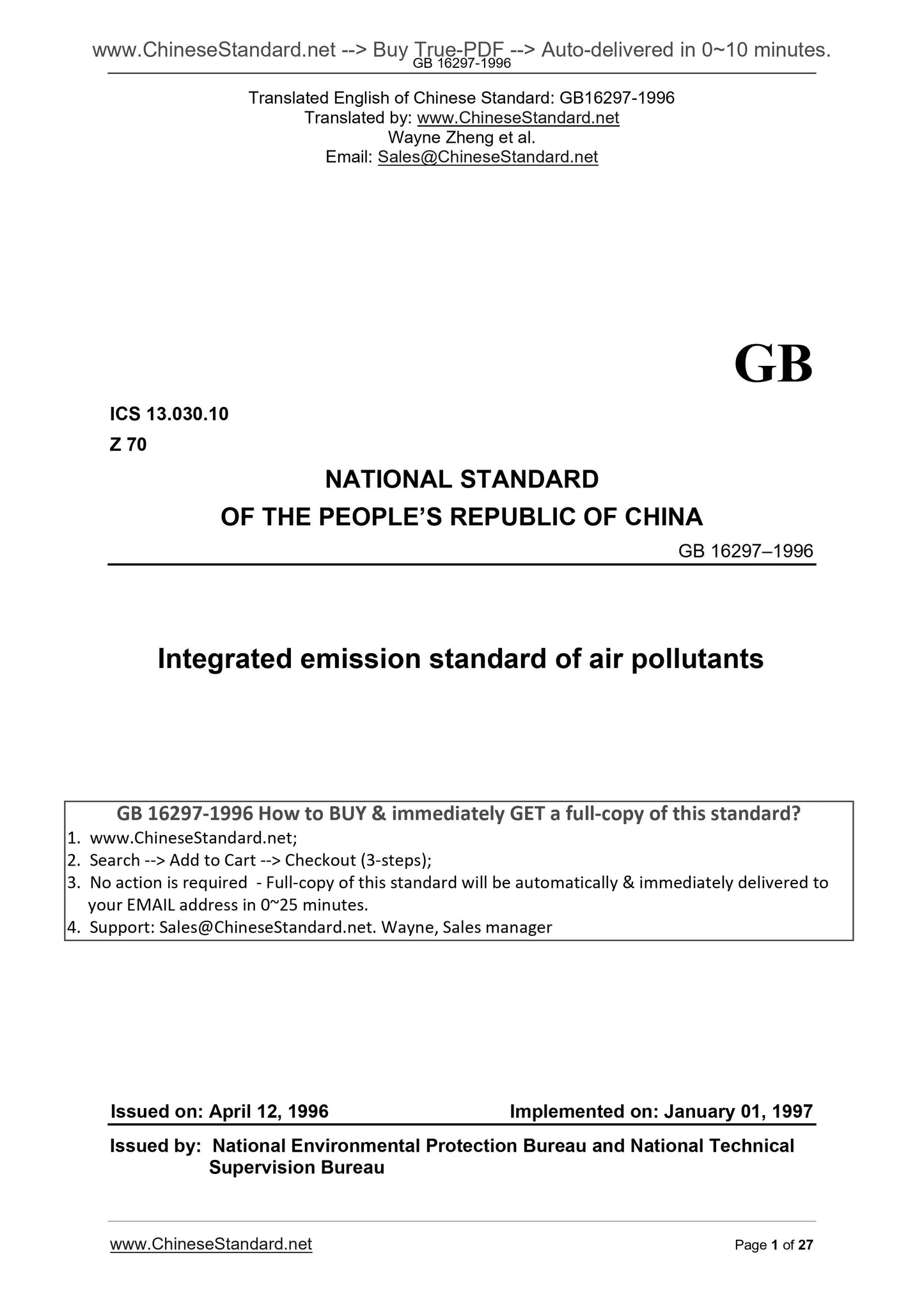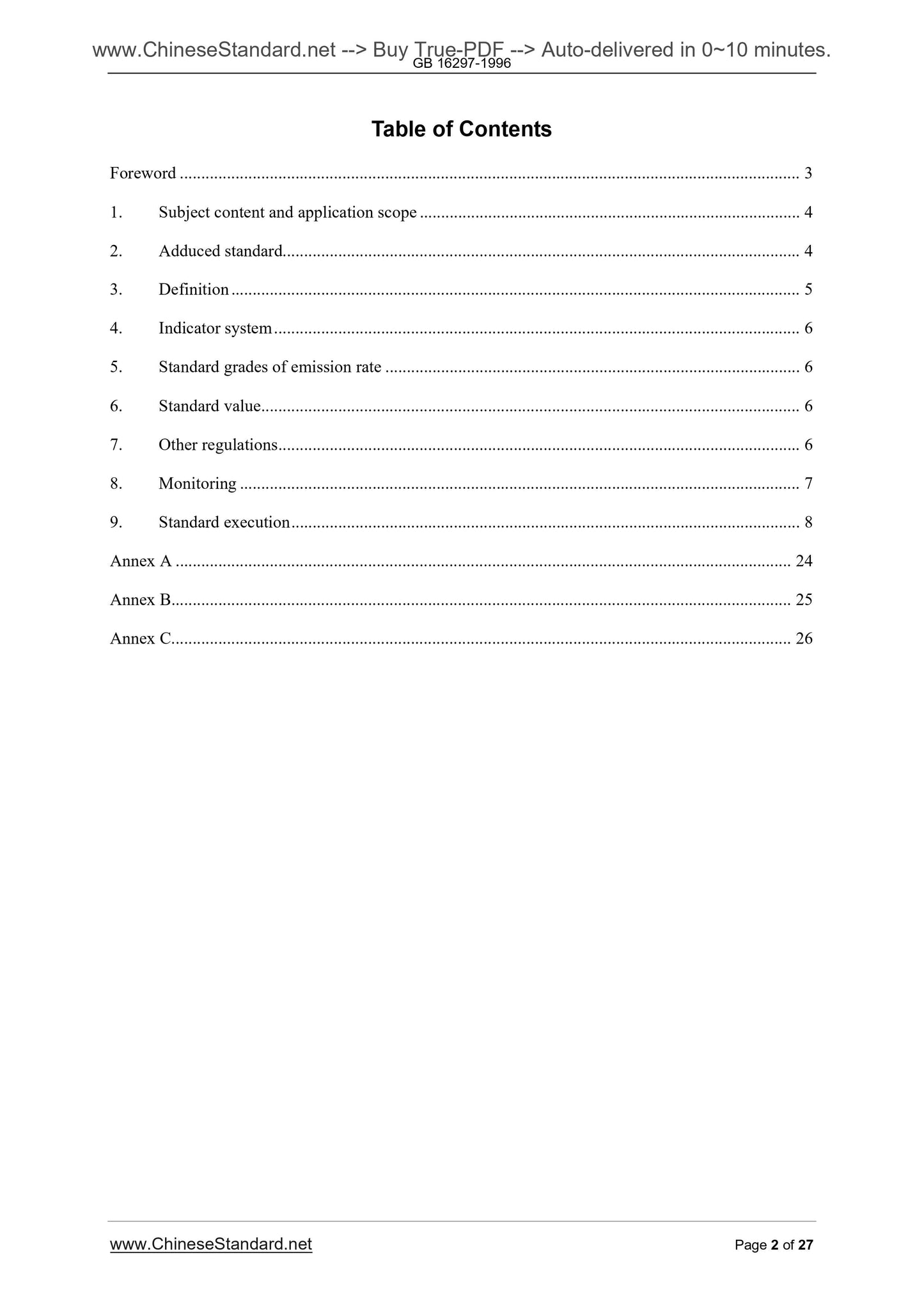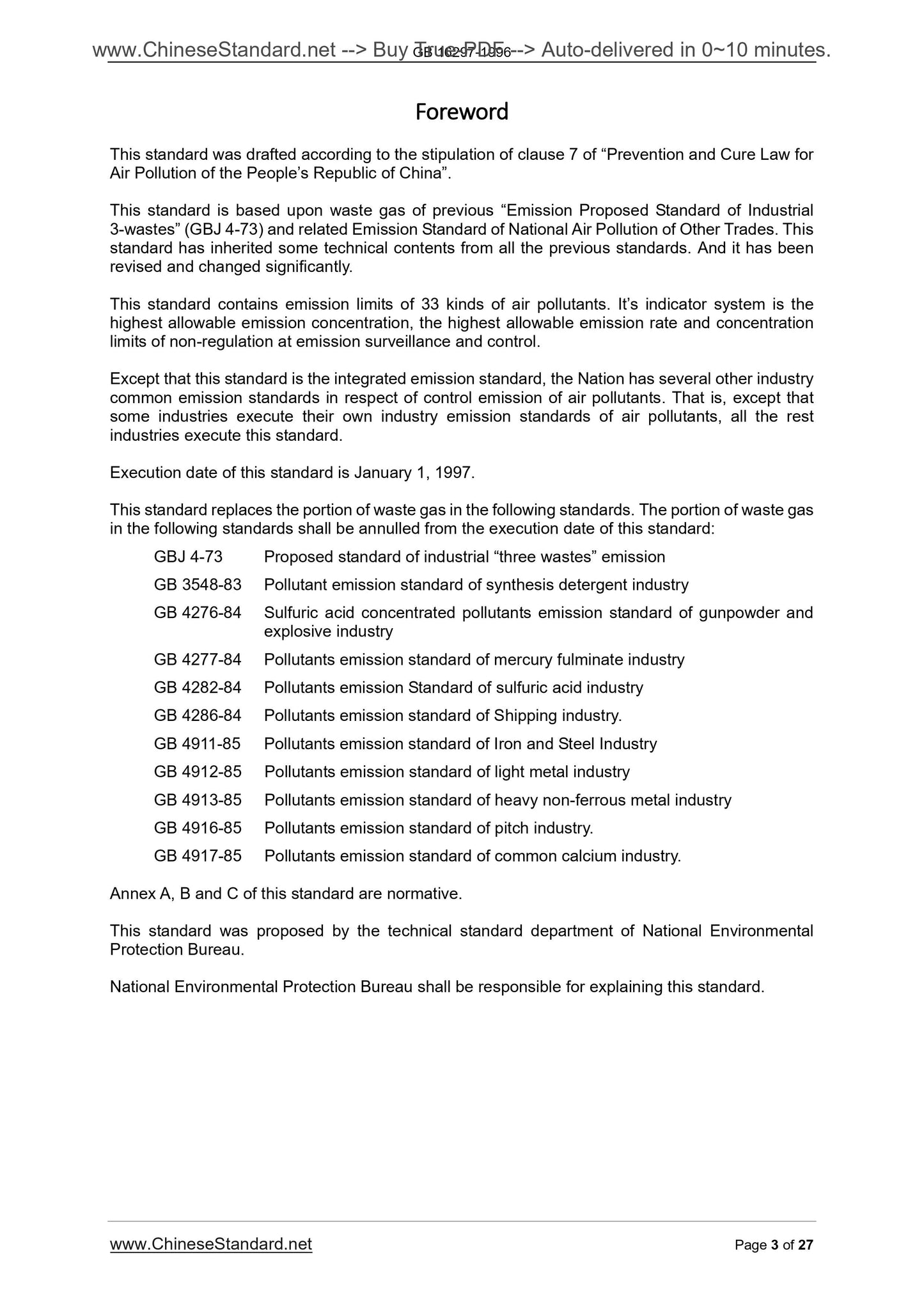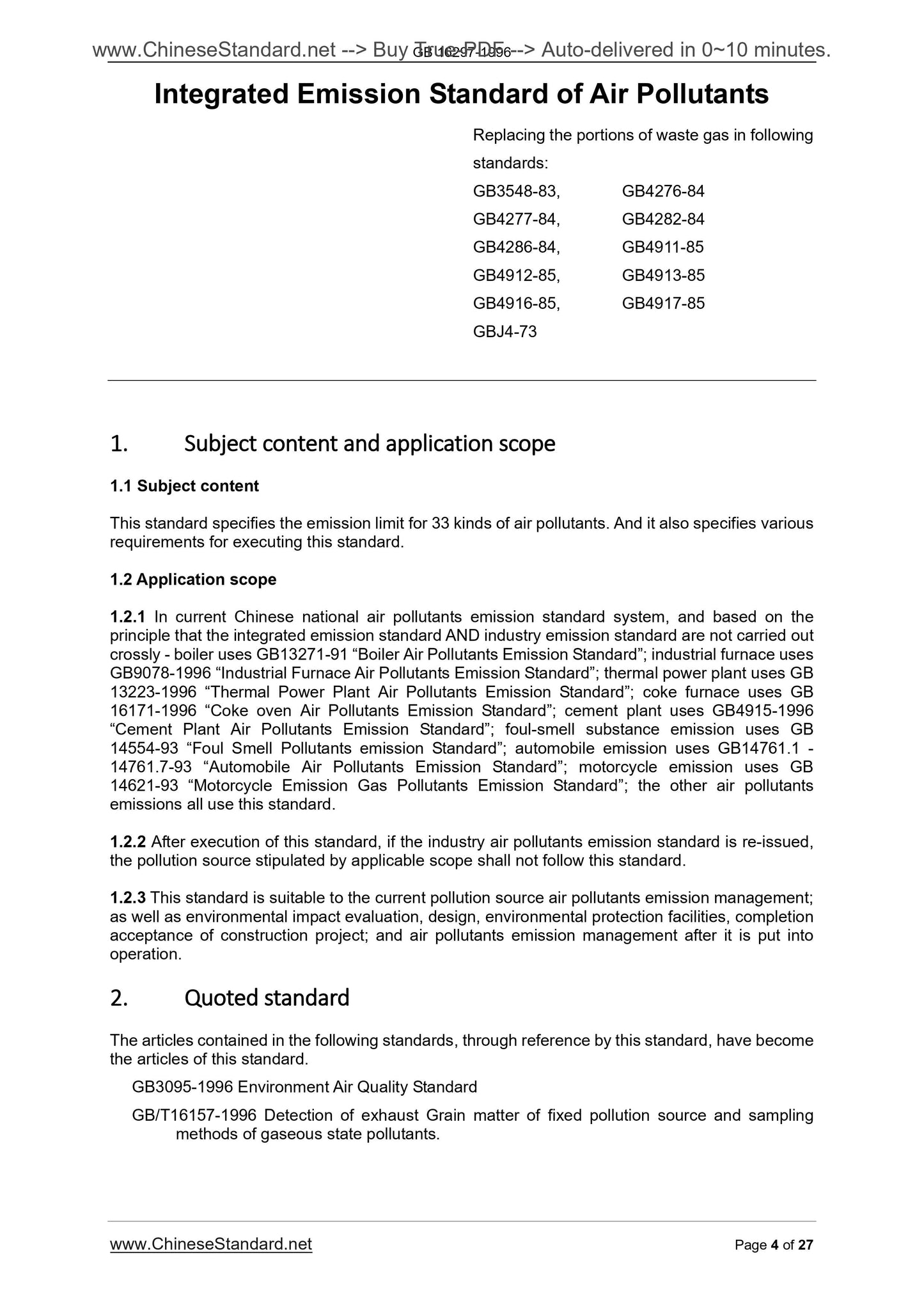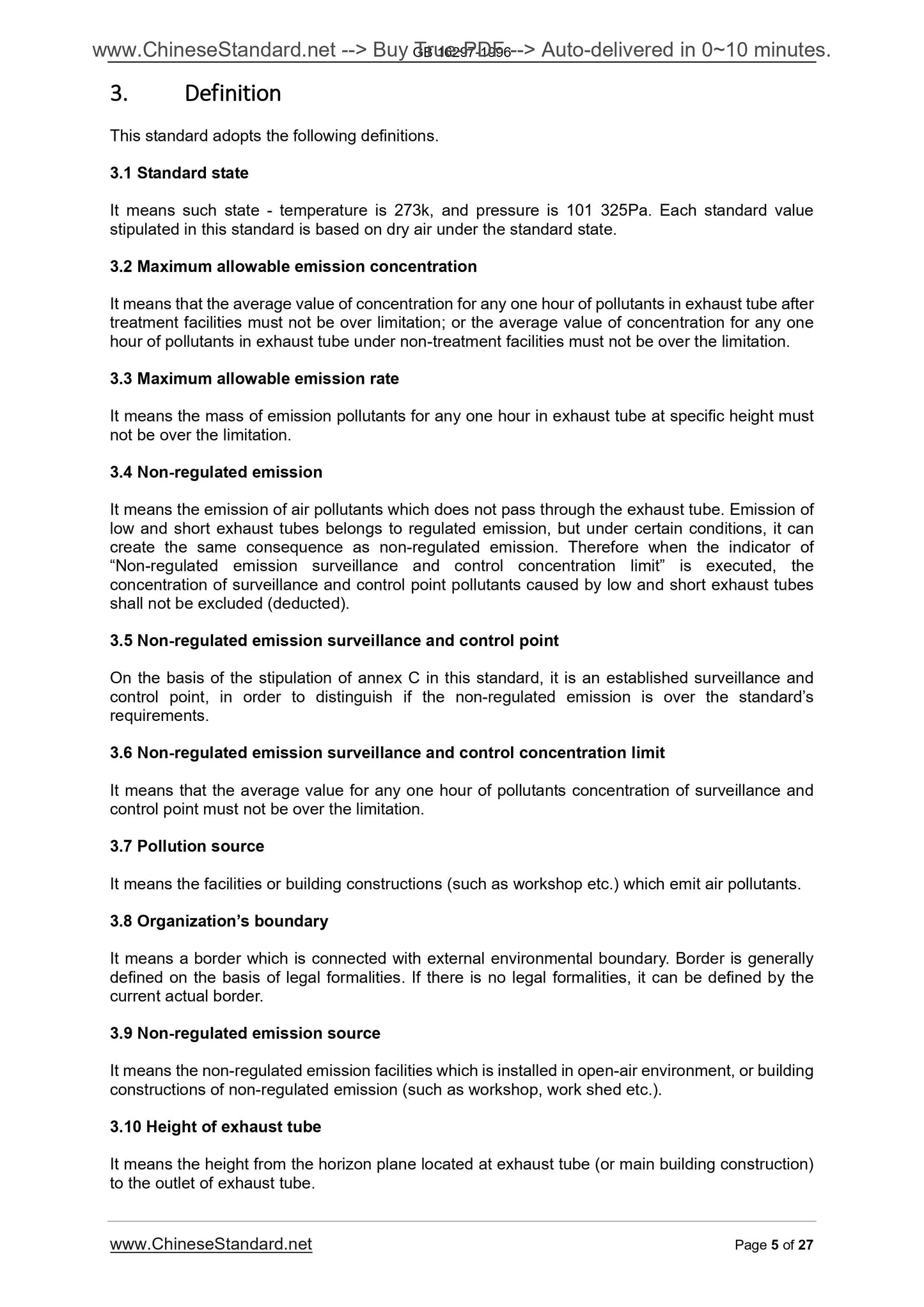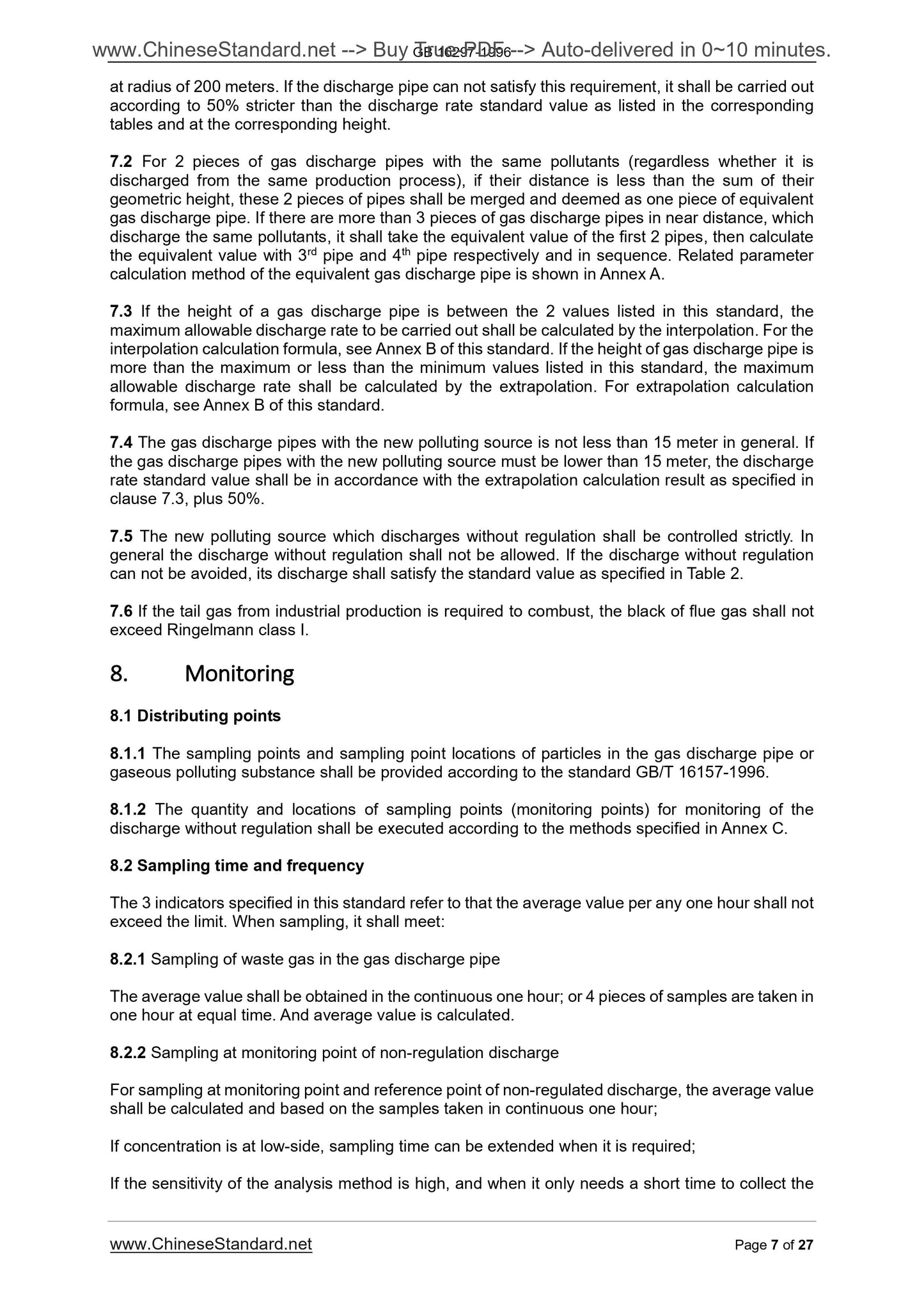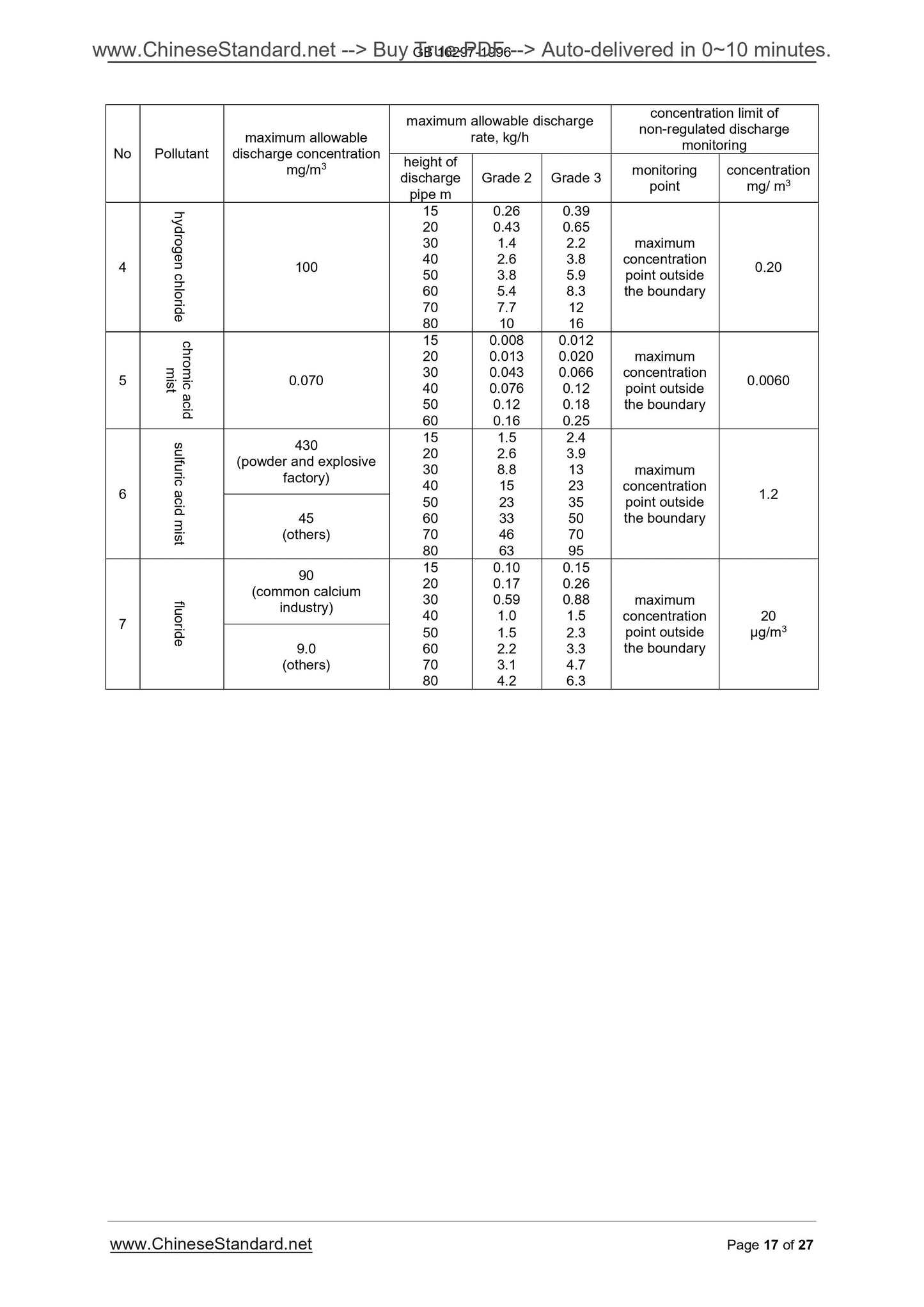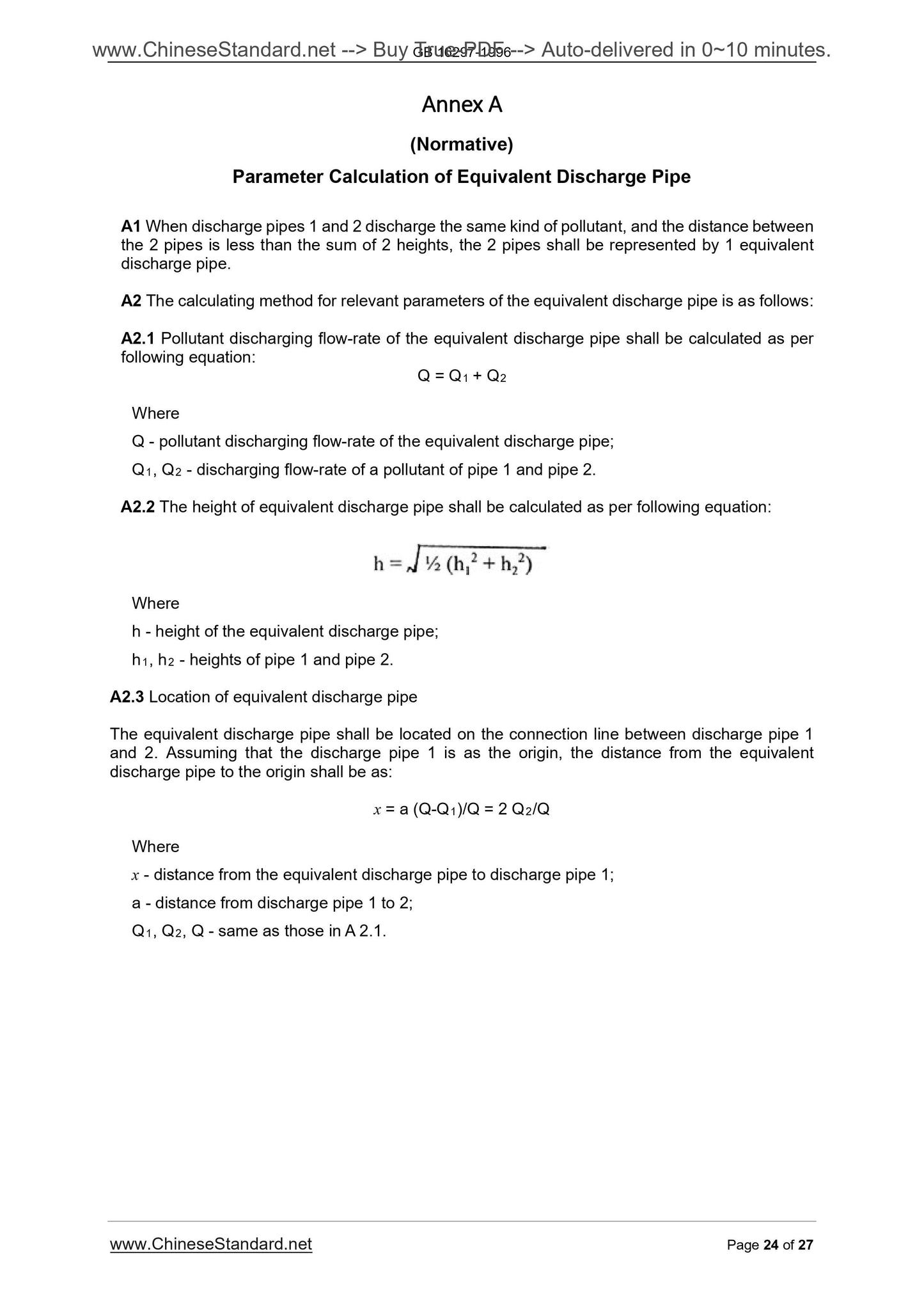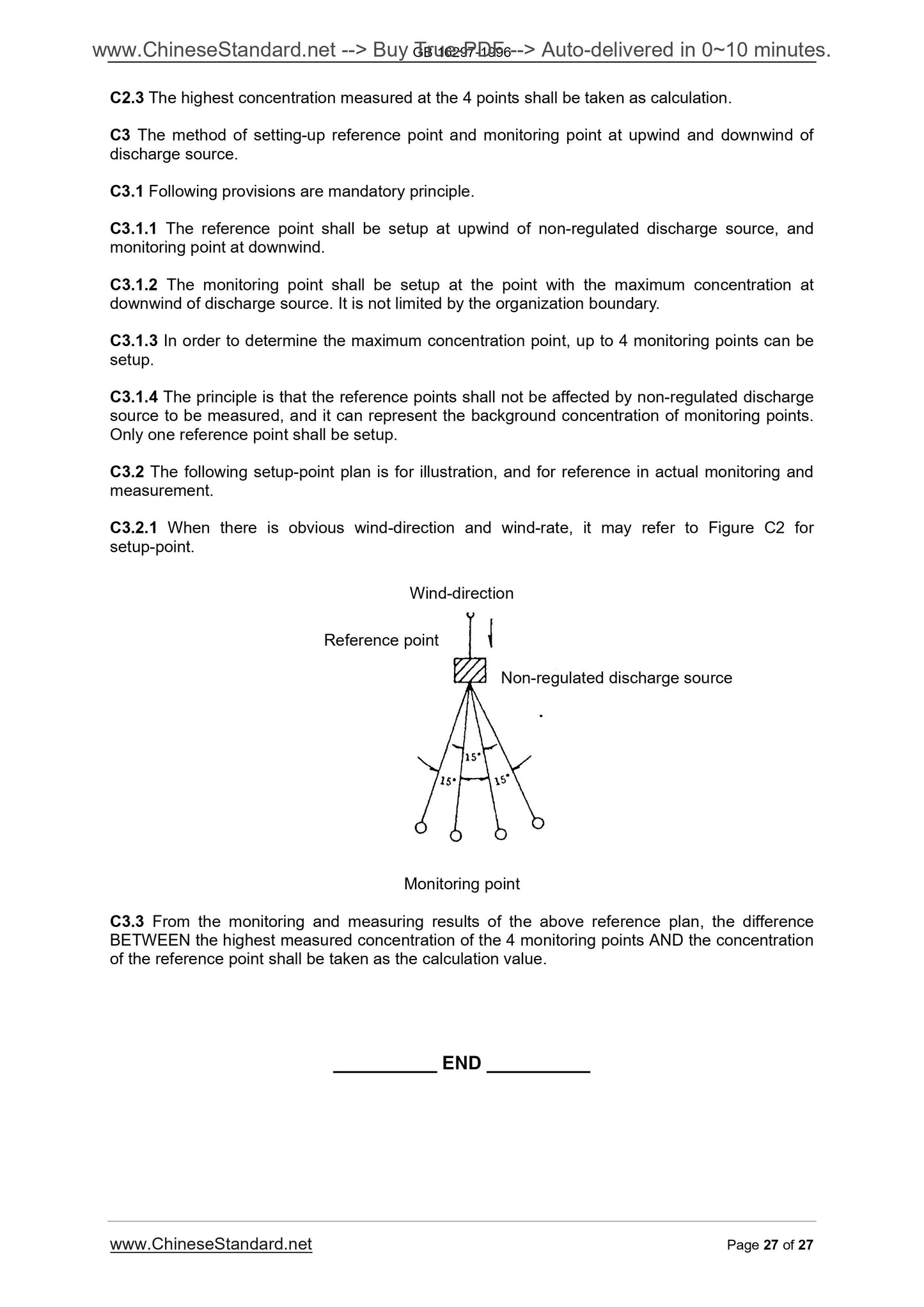1
/
of
9
www.ChineseStandard.us -- Field Test Asia Pte. Ltd.
GB 16297-1996 English PDF
GB 16297-1996 English PDF
Regular price
$145.00
Regular price
Sale price
$145.00
Unit price
/
per
Shipping calculated at checkout.
Couldn't load pickup availability
GB 16297-1996: Integrated emission standard of air pollutants
Delivery: 9 seconds. Download (and Email) true-PDF + Invoice.Get Quotation: Click GB 16297-1996 (Self-service in 1-minute)
Newer / historical versions: GB 16297-1996
Preview True-PDF
Scope
1.1 Subject contentThis standard specifies the emission limit for 33 kinds of air pollutants. And it also specifies various
requirements for executing this standard.
1.2 Application scope
1.2.1 In current Chinese national air pollutants emission standard system, and based on the
principle that the integrated emission standard AND industry emission standard are not carried out
crossly - boiler uses GB13271-91 “Boiler Air Pollutants Emission Standard”; industrial furnace uses
GB9078-1996 “Industrial Furnace Air Pollutants Emission Standard”; thermal power plant uses GB
13223-1996 “Thermal Power Plant Air Pollutants Emission Standard”; coke furnace uses GB
16171-1996 “Coke oven Air Pollutants Emission Standard”; cement plant uses GB4915-1996
“Cement Plant Air Pollutants Emission Standard”; foul-smell substance emission uses GB
14554-93 “Foul Smell Pollutants emission Standard”; automobile emission uses GB14761.1 -
14761.7-93 “Automobile Air Pollutants Emission Standard”; motorcycle emission uses GB
14621-93 “Motorcycle Emission Gas Pollutants Emission Standard”; the other air pollutants
emissions all use this standard.
1.2.2 After execution of this standard, if the industry air pollutants emission standard is re-issued,
the pollution source stipulated by applicable scope shall not follow this standard.
1.2.3 This standard is suitable to the current pollution source air pollutants emission management;
as well as environmental impact evaluation, design, environmental protection facilities, completion
acceptance of construction project; and air pollutants emission management after it is put into
operation.
2. Quoted standard
The articles contained in the following standards, through reference by this standard, have become
the articles of this standard.
GB3095-1996 Environment Air Quality Standard
GB/T16157-1996 Detection of exhaust Grain matter of fixed pollution source and sampling
methods of gaseous state pollutants.
3. Definition
This standard adopts the following definitions.
3.1 Standard state
It means such state - temperature is 273k, and pressure is 101 325Pa. Each standard value
stipulated in this standard is based on dry air under the standard state.
3.2 Maximum allowable emission concentration
It means that the average value of concentration for any one hour of pollutants in exhaust tube after
treatment facilities must not be over limitation; or the average value of concentration for any one
hour of pollutants in exhaust tube under non-treatment facilities must not be over the limitation.
3.3 Maximum allowable emission rate
It means the mass of emission pollutants for any one hour in exhaust tube at specific height must
not be over the limitation.
3.4 Non-regulated emission
It means the emission of air pollutants which does not pass through the exhaust tube. Emission of
low and short exhaust tubes belongs to regulated emission, but under certain conditions, it can
create the same consequence as non-regulated emission. Therefore when the indicator of
“Non-regulated emission surveillance and control concentration limit” is executed, the
concentration of surveillance and control point pollutants caused by low and short exhaust tubes
shall not be excluded (deducted).
3.5 Non-regulated emission surveillance and control point
On the basis of the stipulation of annex C in this standard, it is an established surveillance and
control point, in order to distinguish if the non-regulated emission is over the standard’s
requirements.
3.6 Non-regulated emission surveillance and control concentration limit
It means that the average value for any one hour of pollutants concentration of surveillance and
control point must not be over the limitation.
4. Indicator system
This standard defines the following 3 indicators.
4.1 The maximum allowable emission concentration of pollutants which passes through exhaust
tube emission.
4.2 The pollutants which pass through exhaust tube, based on the maximum allowable emission
rate at specified exhaust tube height.
Any exhaust tube must comply with above 2 indicators simultaneously. If there is 1 item which
exceeds the limit, it is deemed as over-indicator emission.
4.3 For pollutants exhausted in non-regulated way, it shall specifies the surveillance and control
point of non-regulated emission, and the corresponding surveillance and control concentration limit.
5. Standard grades of emission rate
Maximum allowable emission rate specified in this standard is divided into – for present pollution
sources. grade I, II and Ⅲ; for new pollution source. grade II and Ⅲ. According to the classification
of functional area of environmental air quality at where the pollution source is located, relevant
grade emission rate shall be executed. That is.
For pollution source located at class I area, it shall execute grade I standard (At class I area, it
prohibits to have new pollution source or to expand the existing pollution source. When the
existing pollution source located at class I area is built, it shall execute grade I standard of
current pollution source);
6. Standard value
6.1 For polluting source (Herein after referred to as “existing pollution source”) which is set up
before January 1, 1997, it shall execute the standard value listed in Table 1.
6.2 For polluting source (Herein after referred to as “new pollution source”) which is set up before
January 1, 1997 (including new construction, extension and reconstruction, it shall execute the
standard value listed in Table 2.
6.3 Set-up date shall be judged and decided according to the following regulations.
7. Other regulations
7.1 Except for that the height of discharge pipe shall be in accordance with the standard value of
discharge rate, it shall be more than 5 meters higher than the height of those surrounding buildings
at radius of 200 meters. If the discharge pipe can not satisfy this requirement, it shall be carried out
according to 50% stricter than the discharge rate standard value as listed in the corresponding
tables and at the corresponding height.
7.2 For 2 pieces of gas discharge pipes with the same pollutants (regardless whether it is
discharged from the same production process), if their distance is less than the sum of their
geometric height, these 2 pieces of pipes shall be merged and deemed as one piece of equivalent
gas discharge pipe.
7.3 If the height of a gas discharge pipe is between the 2 values listed in this standard, the
maximum allowable discharge rate to be carried out shall be calculated by the interpolation. For the
interpolation calculation formula, see Annex B of this standard.
7.4 The gas discharge pipes with the new polluting source is not less than 15 meter in general. If
the gas discharge pipes with the new polluting source must be lower than 15 meter, the discharge
rate standard value shall be in accordance with the extrapolation calculation result as specified in
clause 7.3, plus 50%.
7.5 The new polluting source which discharges without regulation shall be controlled strictly. In
general the discharge without regulation shall not be allowed. If the discharge without regulation
can not be avoided, its discharge shall satisfy the standard value as specified in Table 2.
7.6 If the tail gas from industrial production is required to combust, the black of flue gas shall not
exceed Ringelmann class I.
8. Monitoring
8.1 Distributing points
8.2 Sampling time and frequency
The 3 indicators specified in this standard refer to that the average value per any one hour shall not
exceed the limit. When sampling, it shall meet.
8.2.1 Sampling of waste gas in the gas discharge pipe
The average value shall be obtained in the continuous one hour; or 4 pieces of samples are taken in
one hour at equal time. And average value is calculated.
8.2.2 Sampling at monitoring point of non-regulation discharge
For sampling at monitoring point and reference point of non-regulated discharge, the average value
shall be calculated and based on the samples taken in continuous one hour;
If concentration is at low-side, sampling time can be extended when it is required;
If the sensitivity of the analysis method is high, and when it only needs a short time to collect the
sampling, it shall use equal-time interval to collect the sample.
8.2.3 Sampling time and frequency under the special condition
If discharge of gas discharge pipe is intermittent, and the discharge time is less than one hour,
continuous sampling in discharge time period shall be taken. Or 2-4 samples shall be sampled by
equal-time interval in discharge time period. And calculate the average value;
8.3 Requirements for monitoring cases
8.3.1 During day-to-day monitoring of polluting source, the cases in sampling period shall be the
same as cases in operation period. The personnel of pollution discharge organization and
personnel of monitoring execution shall not change the operation case at that time at will.
8.3.2 Requirement for the completion acceptance cases for the environment protection facilities of
the construction projection shall be in accordance with the completion acceptance monitoring
methods for the environment protection facilities of the construction project prepared by the State
Environment Protection Bureau.
8.4 Sampling and analysis methods
8.4.1 The analysis methods of pollutants shall be in accordance with the regulations specified by
the State Environment Protection Bureau.
8.4.2 The sampling methods of pollutants shall be in accordance with the standard GB/T
16157-1996 and related parts of the analysis methods as specified by the State Environment
Protection Bureau.
8.5 Measuring of gas discharge amount
The monitoring of gas discharge amount shall be carried out together with sampling and monitoring
of discharge concentration.
9. Standard execution
9.1 If the pollutant source is located at the acid rain control area or sulphur dioxide pollution control
area as approved and specified by the State Council, the sulphur dioxide discharge shall be
executed in accordance with the control standard of the total discharge amount, except this
standard.
9.2 The competent department of the people’s government’s environment protection administration
of the province, autonomous prefecture, municipalities shall decide whether non-regulated
discharge monitoring concentration limit in this standard is carried out in its area, and report to the
environment protection administration competent department of the State Council for the record.
9.3 This standard shall be supervised and executed by the environment protection administration
competent departments of the above-county-level people’s governments.
Basic Data
| Standard ID | GB 16297-1996 (GB16297-1996) |
| Description (Translated English) | Integrated emission standard of air pollutants |
| Sector / Industry | National Standard |
| Classification of Chinese Standard | Z60 |
| Word Count Estimation | 22,265 |
| Date of Issue | 1996-04-12 |
| Date of Implementation | 1997-01-01 |
| Older Standard (superseded by this standard) | GB 3548-1983 ial; GB 4276-1984 ial; GB 4277-1984 ial; GB 4282-1984 ial; GB 4286-1984 ial; GB 4911-1985 ial; GB 4912-1985 ial; GB 4913-1985 ial; GB 4916 -1985 ial; GB 4917-1985 ial; GBJ 4-1973 ial |
| Quoted Standard | GB 3095-1996; GB/T 16157-1996 |
| Regulation (derived from) | Department of Environmental Protection Notice 2010 No. 104 SEPA Notice 2006 No. 46 Announcement of Newly Approved National Standards 2006 No. 9 (No. 96 overall) |
| Summary | This Chinese standard applies to existing sources of air pollutant emission management, and construction of the project's environmental impact assessment, design, and operation of environmental protection facilities after completion and acceptance of the air pollutant emission management. |
Share
